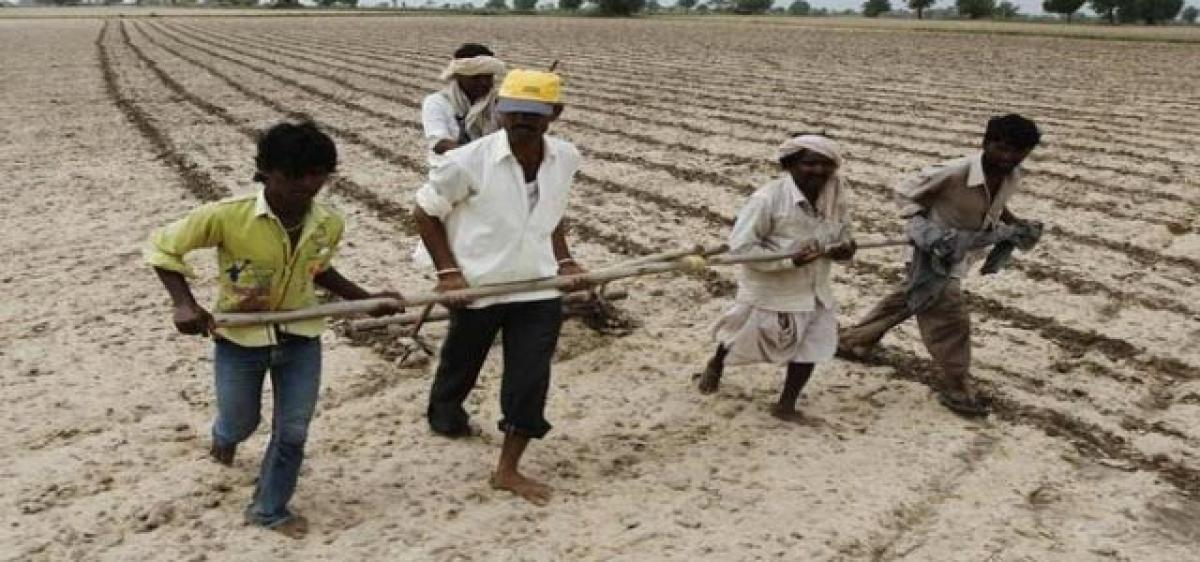Live
- GMR Airports Unveils AI-Powered Digital Twin Platform to Transform Airport Operations
- India poised to become leading maritime player: PM Modi
- Top Causes of Kidney Stones and How to Recognize Silent Symptoms
- India’s renewable energy capacity logs 14.2 pc growth at 213.7 GW
- Winter Session of Odisha Assembly adjourned sine die
- Biden calls Trump's tariff approach 'major mistake'
- After Drama Over Eknath Shinde’s Chief Minister Race, Maharashtra Cabinet Formation Faces New Tensions
- Egyptian FM, Blinken discuss recent developments in Syria
- Iran's supreme leader says Syria's developments result of US-Israeli 'plot'
- Elon Musk to Purchase $100 Million Luxury Mansion Next to Donald Trump's Mar-a-Lago, Report Reveals
Just In

The non-farm sector is now contributing about 2/3rd of the rural economy. But its growth is also stagnant and there are supply side bottlenecks in terms of higher cost of production, lack of logistics, frequent power cuts and lack of skilled manpower. Still about 95% of rural economy is informal.
The rural economy has been stagnant and more volatile for the last three years. Although the area under rabi crops is 2% higher than normal this year, fertilisers use decreased by 7%, indicating slowdown in input use and probable reduction in output. Overall, agricultural sector growth may not exceed 3.5% per annum.
The non-farm sector is now contributing about 2/3rd of the rural economy. But its growth is also stagnant and there are supply side bottlenecks in terms of higher cost of production, lack of logistics, frequent power cuts and lack of skilled manpower. Still about 95% of rural economy is informal.
The recent demonetisation adversely impacted rural and informal sectors more than the formal/urban sector. The informal sector is suffering from technological backwardness and underemployment. It seems with the development there was a more of backwash effect with skilled manpower and capital moving to urban areas then the spread effect in the rural India.
However, budget is an opportunity to jumpstart production, demand and consumption with more allocation of funds to rural areas along with reallocation of funds to income and employment generation.
Agricultural growth is the key
Even though agriculture contributes only 13% of India’s GDP, it is a source of livelihoods for about 50% of the population. The key role agriculture played in increasing incomes of the poorest of the poor cannot be ignored.
Hence, the ongoing flagship programmes like Rastriya Krishi Vikas Yojana(RKVY) to increase farmers’ incomes, Prime Minister Krishi Sinchayi Yojana( PMKSY) to increase area under irrigation, Prime Minister Fasal Bhima Yojana(PMFBY) to increase coverage of crop insurance and e-National Agricultural Markets (NAM) for increasing market efficiency need to be given high priority with more fund allocation along with proper monitoring to reach the benefits to small and marginal farmers.
Employment guarantee, PDS and housing
The role of employment guarantee programme (MGNREGA) and Public Distribution System (PDS) is noteworthy in removing poverty. Some studies pointed out that if MGNREGA and PDS function well in the rural areas, they lift incomes of the poor on average 12%, which is a significant amount. There is a need for increasing rural consumption through putting money in the hands of consumers. The budget for employment guarantee programme, PDS, infrastructure projects like construction of rural roads, rural housing should be given high priority.
Improving terms of trade for agriculture and rural sector
In the recent past, terms of trade are going against the farming sector with increase in cost of cultivation mainly in terms of higher wage rates (labour charges), seed prices and pesticide prices. The prices of inputs are increasing but the prices of outputs are decreasing in agricultural sector. As a result, farming is becoming economically unviable.
It is also true for the most of the khadi and village industries. Distress migration from rural to urban is increasing because of unviable nature of agriculture as well as rural industries. Hence there is a need to focus on price or income support not only for agricultural sector but also to village and khadi industries.
Situation of tenant farmers
Land-lease rates were increased significantly in the recent years. As a result, economic viability of tenant farmers is questionable. There is increased distress and suicides among tenant farmers. Tenants have to pay about 30% to 40% of the average sales value of production to landlords for leasing-in land in most of the villages. This is unbearable if the crop fails, as it happens once in every three years.
Further, tenants are not eligible to avail of government schemes like subsidised seed, bank loan and subsidies on drip etc. There is a need for a clear policy on land-lease markets in line with the recent NITI Aayog report to reduce burden on the tenants at the same time protecting the ownership rights of landowners.
Degree of uncertainty about future
Uncertainty of agriculture is not decreased rather it increased over the years due to increased share of commercial crops, high fluctuation in prices, more use of purchased inputs and climate change. Farmers’ incomes are now more volatile than the last ten years. There is no government programme/policy to reduce this uncertainty.
Although, there was price stabilisation fund, fund allocation and strength of implementing agencies are meager to effectively implement the programme. There is a need for concerted efforts to reduce this degree of uncertainty not only among farming community but also rural artisans.
Extra helping hand to farm and rural sector
Overall, this budget needs to give extra helping hand to the farmers, village artisans and rural industries to increase and stabilise their incomes, so that their future is secured and medium term goal of doubling farmers income by 2022 will be achieved. (Writer is Director, National Institute of Agricultural Extension Management, MANAGE, Hyderabad)
By A Amarender Reddy

© 2024 Hyderabad Media House Limited/The Hans India. All rights reserved. Powered by hocalwire.com







